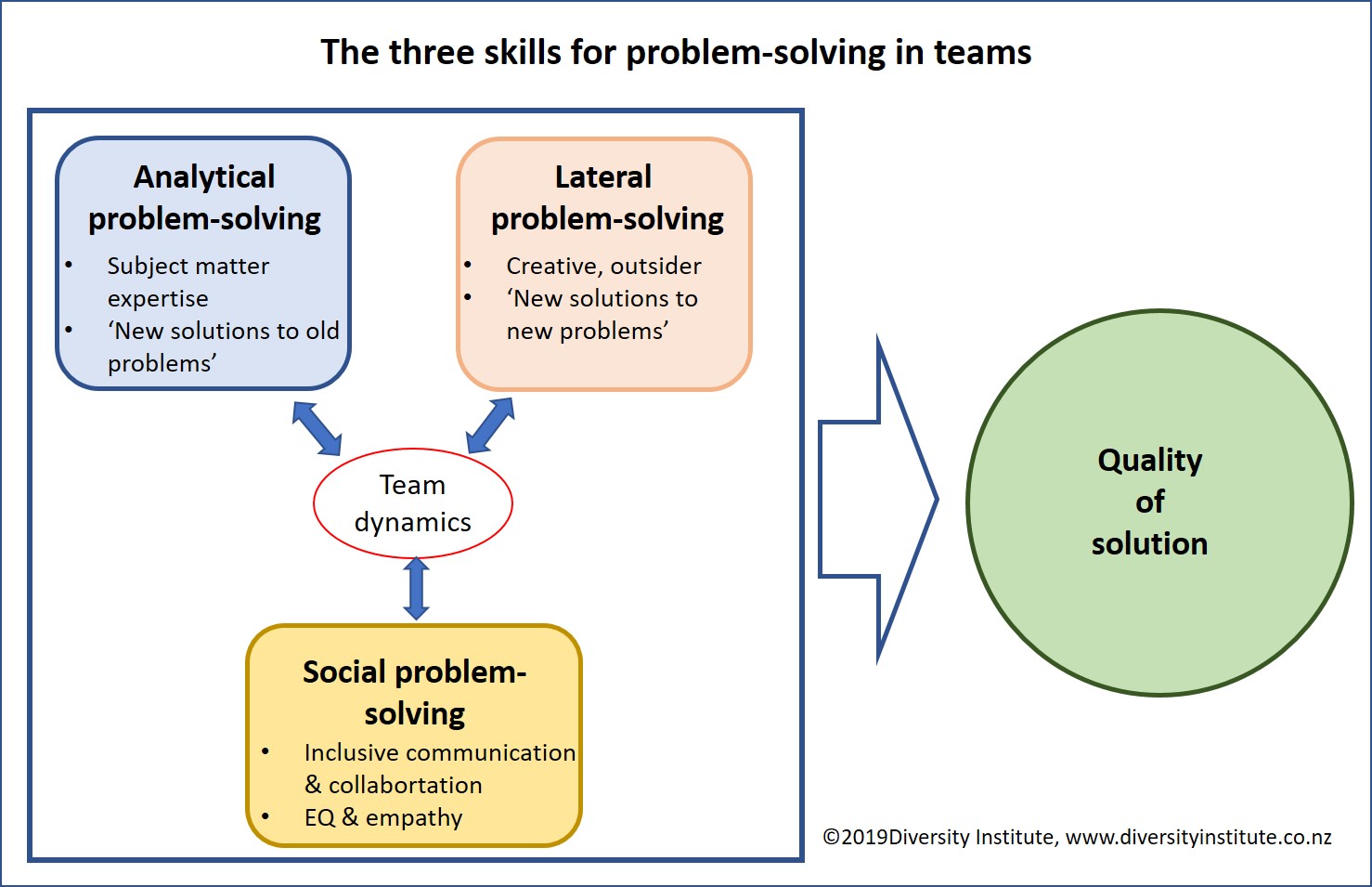When everything changes around us, we are heavily relying on our problem-solving skills to adapt. Problem-solving skills are hugely desirable now, and they are increasingly important in future, Word Economic Forum, Jan 2016, The Future of Jobs. In this article I share 5 tips on problem-solving during Covid-19.
Fortunately, we are quite good in analytical problem- solving. Define the problem, create options, select the best option based on some criteria, test & prototype if possible, refine, and implement. Done.
What is different during Covid-19?
- Increased need for creativity. Our world just changed at least for the foreseeable future. We’ll have to solve new problems with new solutions.
- Increased need for social skills around effective collaboration, communication, EQ, empathy, and the ability to actively solicit and integrate diverse views. This was already an underdeveloped skill in many teams before Covit19. Now it has the added challenge of social skills in remote teams.
I consider the current dominant analytical skill set for problem-solving insufficient to solve the problems of today. The complexity of problems we face today often requires a range of specialists or subject matter experts to collaborate. Let’s have a closer look at the intersection between analytical problem-solving, lateral/creative problem-solving and social skills.
- Analytical Problem-Solving. People have certain technical skills in relation to the problem. For example, engineers have skills to identify the cause of an engine failure. People know their subject and can make valuable contributions by applying logic and analytical thinking.
- Lateral/Creative Problem-Solving. People have skills in connecting the problem in an unusual, creative way. They can see things that don’t exist (yet). Those people may or may not have technical skills in relation to the problem. Just ask kids how they would solve the climate crisis!
- Social Skills in Problem-Solving. People have skills in taking care of the social dynamics in the team while solving the problem. For example, they help the team to effectively collaborate with good communication, EQ, empathy, and the ability to actively solicit and integrate diversity.

Tip 1: Identify the problem-solving skills in the team
A team of outstanding analytical skills is not much use when they shout at each other. A team of super creatives lack the technical understanding to translate a vision into reality. A team with fantastic social skills may spend too much time on their relationships and not enough time on the task. Team members usually have one strength in either analytical, lateral, or social problem-solving skills. As a team they can complement each other but ideally, each team member has at least a basic skill level in all areas. You know what I mean if you ever came across a person with unbearable behaviours that everyone tolerated because they are a super star in their field.
- Which of the 3 areas (analytical, lateral, social) is your strength?
- What is the problem-solving strength of each team member?
- Are any of those 3 areas over/underrepresented in the team?
- What is the implication of that?
Tip 2: Invite diversity of thought
Teams have often a good functional diversity, for example, the managers of Production, Sales, HR, Finance come together, or a range of technical specialists in an R&D team. Research suggests that adding social diversity, for example, a mix of gender and ethnicities can further increase the problem-solving abilities of the team for two reasons. First, they bring more diverse perspectives to the issue. Second, adding social diversity “…makes people believe that differences of perspective might exist among them and that belief makes people change their behavior’.[Scientific American] Increased social diversity makes us more creative, more diligent and harder-working because compared to a more homogenous group we anticipate differences of opinion and challenges. We prepare better and are mentally more awake and present because our brain is forced to process complex and unexpected information and we expect that it is harder to collaborate and reach an outcome or agreement. Diversity gives our brain a powerful workout.
Diversity of thought can flourish in an inclusive environment, a space of psychological safety, where the contributions of individuals are encouraged, heard, and appreciated no matter how different they are. This can be achieved by applying an opportunity mindset. A mindset that allows us to listen to different views with curiosity, not with judgement. When people see differences as an opportunity they can resolve those differences and potential conflict in a constructive way.
Tip 3: Get everyone to participate
Make yourself heard if you have a different view or a contribution to make and help others to do so. Sometimes people mistakenly assume they are not loyal to their team when they express a different perspective or dissent. The opposite is the case. Sometimes they don’t want to rock the boat and shy away from a discussion. In that case, the team runs the risk of approaching a problem only from one perspective. A strong desire to reach consensus increases tunnel vision and blind spots. At best, the team arrives at suboptimal solutions, at worst they lose serious money and reputation. How can we get everyone to participate and share their views?
- Ask in the meeting invite to come prepared with some thoughts on a specific topic. Introverts will feel more comfortable as they had time to think through their contribution and extroverts have time to bring some structure to their thoughts that makes it easier for others to follow.
- At the meeting, give everyone the same time to share their thoughts first, without the whole team starting to discuss them. Only questions to clarify understanding are appropriate in this first round of participation. The timekeeper, facilitator, or chair intervenes when people are taking up more time. Each contribution should be recorded on a whiteboard or post-it to ensure that even the most diverse perspectives are not skimmed over.
- The second round of participation is about reflecting on the contributions made, sharing what resonates and why, prioritising, deciding on what should be further explored and what information is still required.
Tip 4: Increase tolerance for disagreements
Diversity of thought is often smothered by the urge to have consensus. We can encourage diversity of thought with the expectation that there will be (and should be) tensions in the team. For example, there should be a healthy tension between Marketing and Operations because the needs and desires of those departments are often in conflict. Marketing is coming up with fancy ideas on packaging to attract customers while Operations would like to keep it simple and consistent to be more efficient. Task conflict is good, relationship conflict isn’t. Relationship conflict occurs when different views become a personal matter, with egos, power struggles and negative feelings playing out. If the team, however, articulates the natural tensions in the conflict between functions, it becomes normal to voice different views. Team members also learn about each other’s’ stressors which helps to increase their tolerance towards differences.
Diverse perspectives keep flowing better when we normalise disagreements. We can give team members added responsibilities around boosting the collective social skills of the team. For example, one person takes on the role of a Process Observer. While it is important for everyone to be mindful of team dynamics, someone can take the additional responsibility of helping others to listen, speak uninterrupted, and advocate for the use of inclusive language. The Process Observer is also more likely to intervene when judgements and assumptions are made or when people are getting personal. One team member can take on a ‘Devil’s Advocate’ role to avoid group think. They are mandated to share what could go wrong and why a solution would not work. When those roles are rotated between the team, each member becomes more agile in taking different perspectives and not one person is associated with, for example, the ‘Devil’s Advocate’.
Tip 5: Get to know the team on a personal and emotional level
Connecting on a personal level is the foundation for a safe, empathetic, and caring environment. People who are working together on a regular basis benefit from knowing the person they are working with beyond their positions and relevant skills. What are they interested in outside of work? What happens in their lives? What is important to them? The personal, human connection allows people to speak up and listen with an open mind. The personal connection enables people to be honest, humble, even vulnerable, which are all expressions of a psychological safe environment. When we know each other on a personal level we are more likely to find the right words in case we disagree, and we are more likely to be empathetic when we resolve differences.
In summary
Problem-solving teams require problem-solving skills and social skills. Diverse teams successfully solve complex problems when they understand how to interact in an inclusive way, when they expect to have different views and disagreements, and connect on a personal and emotional level.
At the Diversity Institute we help people to better connect, collaborate and resolve differences. Please reach out, connect, and leave your comments.
Sources
- The World Economic Forum, 2016, The Future of Jobs
- Katherine W. Phillips, 2014, How Diversity Makes Us Smarter, Scientific American


